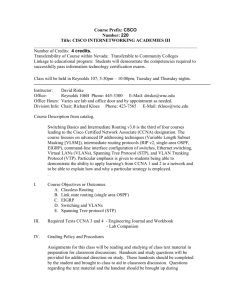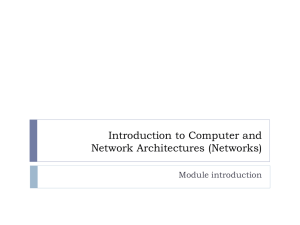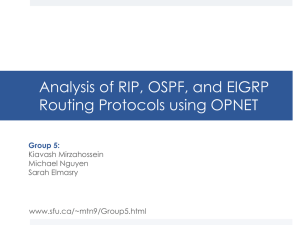Analysis of RIP OSPF and EIGRP routing protocols using opnet
advertisement
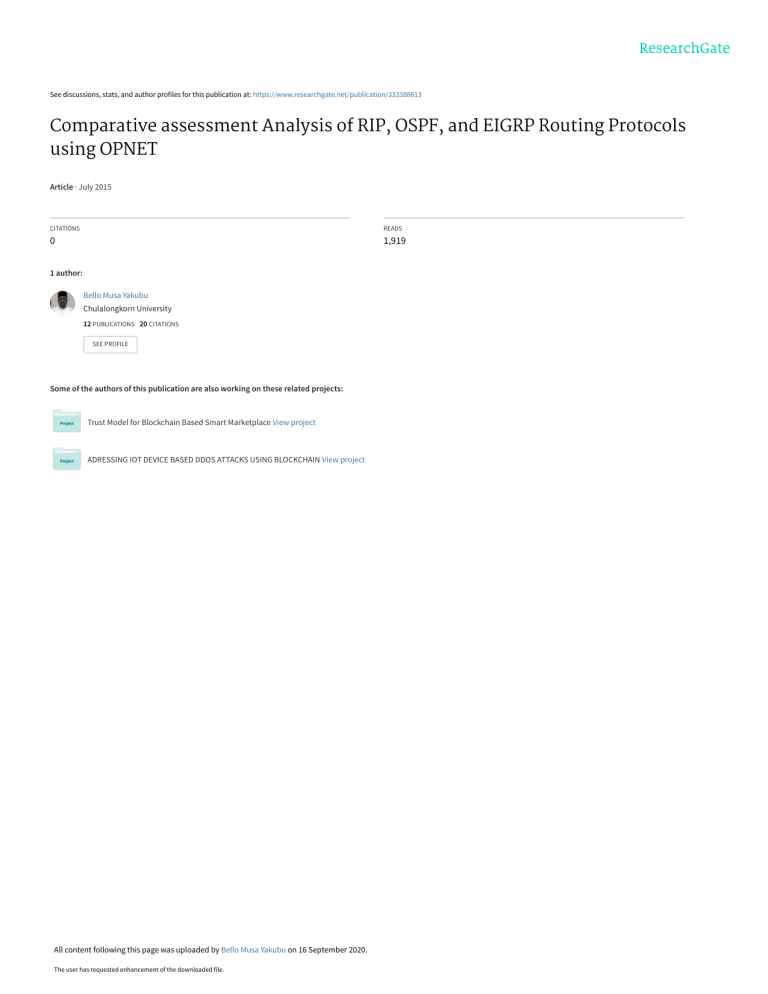
See discussions, stats, and author profiles for this publication at: https://www.researchgate.net/publication/333388613 Comparative assessment Analysis of RIP, OSPF, and EIGRP Routing Protocols using OPNET Article · July 2015 CITATIONS READS 0 1,919 1 author: Bello Musa Yakubu Chulalongkorn University 12 PUBLICATIONS 20 CITATIONS SEE PROFILE Some of the authors of this publication are also working on these related projects: Trust Model for Blockchain Based Smart Marketplace View project ADRESSING IOT DEVICE BASED DDOS ATTACKS USING BLOCKCHAIN View project All content following this page was uploaded by Bello Musa Yakubu on 16 September 2020. The user has requested enhancement of the downloaded file. IJMIE July 2015 Volume 5, Issue 7 ISSN: 2249-0558 ________________________________________________________ Comparative assessment Analysis of RIP, OSPF, and EIGRP Routing Protocols using OPNET Bello Musa Yakubu* Abstract. In a network topology various protocols are used for forwarding the packets. The extent of information stored by a router about the network depends on the algorithm it follows. Most of the popular routing algorithms used are RIP, OSPF, IGRP and EIGRP. There are different classes of routing protocols, two of which are Exterior Gateway Protocol (EGP) and Interior Gateway Routing (IGR). A routing protocol can be dynamic or static, as well as distance-vector or link-state. In this paper, attention is given to Routing Information Protocol (RIP), Open Shortest Path First (OSPF), and Enhanced Interior Gateway Routing Protocol (EIGRP). All these three protocols are dynamic IGP’s, meaning that these protocols route packets within one Autonomous System (AS). RIP is a distance-vector protocol; EIGRP is an enhanced distance vector protocol developed by Cisco and OSPF is a link-state routing protocol. Detailed descriptions of these routing protocols are provided later in this report. An analytical Study shall be carried out on these protocols in terms of their: convergence, throughput, queuing delay, and utilization through simulation which has been attempted using OPNET as simulating tool. The task here is to find out which protocol suits the best for a client network. Keywords:rip, ospf, eigrp, opnet, convergence, throughput, queuing delay, utilization, protocol. * Department of Computer Science, School of Engineering Technology, Sharda University, Greater Noida-201306, UP-India A Monthly Double-Blind Peer Reviewed Refereed Open Access International e-Journal - Included in the International Serial Directories Indexed & Listed at: Ulrich's Periodicals Directory ©, U.S.A., Open J-Gage as well as in Cabell’s Directories of Publishing Opportunities, U.S.A. International Journal of Management, IT and Engineering http://www.ijmra.us 1 IJMIE July 2015 Volume 5, Issue 7 ISSN: 2249-0558 ________________________________________________________ 1 INTRODUCTION The primary purpose of routers is to forward the internet protocol (IP) packets. To quickly adapt the changes which occur in a network, the routing protocol uses various algorithms, processes and messages. According to the characteristics of routing protocols, the protocols are classified in various groups. At the network layer, there are two classes of protocols: routed and routing protocols. A routed protocol is responsible for the transportation of packets across a network and the responsibility of routing protocols is to appropriately direct the packets from source to destination. At the network layer IP is considered as routed protocol and the various routing protocols are: 1. Routing Information Protocol (RIP) 2. Internet Gateway Routing Protocol (IGRP) 3. Open Shortest Path First (OSPF) 4. Enhanced Internet Gateway Routing Protocol (EIGRP) On the network layer, achieving routing convergence, the process in which routing tables are updated, is a crucial and complex process. At every topology change, including a link failure or recovery, the routing tables need to be updated at which time the convergence process takes place. The task of updating these tables is accomplished by routers that communicate according to a set of rules set by routing protocols. The main goals of any routing protocol are to achieve fast convergence, while remaining simple, flexible, accurate and robust. Consequently, the result that care more about performance, measurement and verification is needed, which calls for the contribution of this paper work. The first goal is to study about routing protocols and thus to enhance the knowledge as well. The second goal is to be familiar with OPNET simulator and to implement the proposed network models in OPNET. In this paper, three routing protocols are considered: RIP, EIGRP and OSPF. The research question is; which protocol among RIP, EIGRP and OSPF suits the best for the network? This gives the client an ability to make the right selection of the most effective protocol that will best fit his organization and satisfies his needs. 2LITERATURE SURVEY The comparison of the performance of three Intra-domain routing protocols EIGRP, RIP and OSPF for LAN network was carried out (Singh & Mahajan, August 2013), similarly, a comparative analysis of EIGRP and OSPF interior routing protocols has been carried out A Monthly Double-Blind Peer Reviewed Refereed Open Access International e-Journal - Included in the International Serial Directories Indexed & Listed at: Ulrich's Periodicals Directory ©, U.S.A., Open J-Gage as well as in Cabell’s Directories of Publishing Opportunities, U.S.A. International Journal of Management, IT and Engineering http://www.ijmra.us 2 July 2015 IJMIE Volume 5, Issue 7 ISSN: 2249-0558 ________________________________________________________ (Shafiul , Khan, Nazrul Islam, & Ashique, 2013). The analysis has been done on a single network with proposed protocols on real time applications. Protocol performance has been evaluated on the basis of proposed parameters ( Nazrul Islam & Ashique, September 2010). The main aim of this paper is to find which routing protocol would serve best based on applications running in our network topology. The application can be classified into real time and non-real time (Das, Subedi, & Shekar V, May, 2014). According to Gehlot et al. (2014), “the performance of the Best effort and Quality of Service methods were used to evaluate the performance of EIGRP and OSPF routing protocols under various parameter (i.e. traffic in network, voice and video traffic send/receive, packet delay variation and packet end-to-end delay) to judge the impact under both methods (i.e. Best-effort and QoS method)” (p. 142). Furthermore, they explain that among both methods, QoS method is good as compared to best effort method as it gives the guarantee for delivery of packets in the network than best effort method which does not provide any guarantee for delivery of packet in the network. They also emphasize the benefit of EIGRP over OSPF based on the above parameters (Gehlot & Barwar, 2014 ). S. Farhangi et al (2012), presented a comparative analysis in a typical semi-meshed network utilizing combination of EIGRP, IS-IS and OSPF routing protocols. The comparative analysis has been done in a network for voice and videoconferencing traffic. The results obtained from the simulations; shows that OSPF/IS-IS scenario has minimal convergence time whereas EIGRP/IS-IS/OSPF scenario has minimum Packet delay variation, packet End to End delay, Voice Jitter and link Throughput. From these results, the authors explain with certainty that combination of three protocols has better performance rather than combination of two protocols. In conclusion, they suggest the combination of three or more protocols to increase efficiency and network performance (S. Farhangi, A. Rostami , & S. Golmohammadi, 2012). OPNET is suggested to be used as the tool to analyze and compare the performance of these three routing protocols that are commonly used in today’s networks: RIP, OSPF, and EIGRP. According to Xu et al., “OPNET Modeler can be employed by network planners to select the most suitable routing protocol for various networks and to design an optimal routing topology” (p.4)(Xu & Trajković). A Monthly Double-Blind Peer Reviewed Refereed Open Access International e-Journal - Included in the International Serial Directories Indexed & Listed at: Ulrich's Periodicals Directory ©, U.S.A., Open J-Gage as well as in Cabell’s Directories of Publishing Opportunities, U.S.A. International Journal of Management, IT and Engineering http://www.ijmra.us 3 July 2015 IJMIE Volume 5, Issue 7 ISSN: 2249-0558 ________________________________________________________ 3 BACKGROUND OF STUDY Routing links together small networks to form huge internetworks that span vast regions. This cumbersome task makes the network layer the most complex in the OSI reference model. The network layer provides the transfer of packets across the network. Routing protocols define the path of each packet from source to destination. To complete this task, routers use routing tables, which contain information about possible destinations in the network and the metrics (distance, cost, bandwidth, etc.) to these destinations. Routers have information regarding the neighbor routers around them. The degree of a router’s network knowledge and awareness depends on the routing protocol it uses. At every change in the network, including link failure and link recovery, routing tables must be updated. The efficiency of these updates determines the efficiency of the routing protocols (Shafiul , Khan, Nazrul Islam, & Ashique, 2013). There are two main types of routing protocols: static routing and dynamic routing. Static routing assumes that the network is fixed, meaning no nodes are added or removed and routing tables are therefore only manually updated. Dynamic or adaptive routing, more commonly used for internetworking, allows changes in the network topology by using routing tables that update with each network change. In this report we will only consider dynamic routing protocols. Within the class of dynamic protocols, we can have Interior or Exterior Gateway Protocols. EGP’s deals with routing information between different autonomous. An example of an EGP is Border Gateway Protocol (BGP). The three routing protocols we chose to compare are IGP’s, protocols that exchange routing information within an AS. These protocols can either use distance vector (such as RIP and EIGRP) or link-state algorithms (such as OSPF) to optimize convergence times. In this paper we will compare the three dynamic routing protocols shown on the right of the hierarchy chart below: RIP, OSPF and EIGRP. A Monthly Double-Blind Peer Reviewed Refereed Open Access International e-Journal - Included in the International Serial Directories Indexed & Listed at: Ulrich's Periodicals Directory ©, U.S.A., Open J-Gage as well as in Cabell’s Directories of Publishing Opportunities, U.S.A. International Journal of Management, IT and Engineering http://www.ijmra.us 4 July 2015 IJMIE Volume 5, Issue 7 ISSN: 2249-0558 ________________________________________________________ Routing Protocols Figure 1: Hierarchy Chart of Routing Protocols 3.1 Routing Information Protocol (RIP) The Routing Information Protocol (RIP), which is a distance-vector based algorithm, is one of the first routing protocols implemented on TCP/IP. Information is sent through the network using UDP. Each router that uses this protocol has limited knowledge of the network around it. This simple protocol uses a hop count mechanism to find an optimal path for packet routing. A maximum number of 16 hops are employed to avoid routing loops. However, this parameter limits the size of the networks that this protocol can support. The popularity of this protocol is largely due to its simplicity and its easy configurability. However, its disadvantages include slow convergence times, and its scalability limitations. Therefore, this protocol works best for smallscaled networks. 3.2 Open Shortest Path First (OSPF) Open Shortest Path First (OSPF) is a very widely used link-state interior gateway protocols (IGP). This protocol routes Internet Protocol (IP) packets by gathering link-state information from neighboring routers and constructing a map of the network. OSPF routers send many message types including hello messages, link state requests and updates and database descriptions. Djisktra’s algorithm is then used to find the shortest path to the destination. Shortest Path First (SPF) calculations are computed either periodically or upon a received Link State Advertisement (LSA), depending on the protocol implementation. Topology changes A Monthly Double-Blind Peer Reviewed Refereed Open Access International e-Journal - Included in the International Serial Directories Indexed & Listed at: Ulrich's Periodicals Directory ©, U.S.A., Open J-Gage as well as in Cabell’s Directories of Publishing Opportunities, U.S.A. International Journal of Management, IT and Engineering http://www.ijmra.us 5 IJMIE July 2015 Volume 5, Issue 7 ISSN: 2249-0558 ________________________________________________________ are detected very quickly using this protocol. Another advantage of OSPF is that its many configurable parameters make it a very flexible and robust protocol. Contrary to RIP, however, OSPF has the disadvantage of being too complicated. 3.3 Enhanced Interior Gateway Routing Protocol (EIGRP) EIGRP is a Cisco-developed advanced distance-vector routing protocol. Routers using this protocol automatically distribute route information to all neighbors. The Diffusing Update Algorithm (DUA) is used for routing optimization, fast convergence, as well as to avoid routing loops. Full routing information is only exchanged once upon neighbor establishment, after which only partial updates are sent. When a router is unable to find a path through the network, it sends out a query to its neighbors, which propagates until a suitable route is found. This need-based update is an advantage over other protocols as it reduces traffic between routers and therefore saves bandwidth. The metric that is used to find an optimal path is calculated with variables bandwidth, load, delay and reliability. By incorporating many such variables, the protocol ensures that the best path is found. Also, compared to other distance-vector algorithms, EIGRP has a larger maximum hop limitation, which makes it compatible with large networks. The disadvantage of EIGRP is that it is a Cisco proprietary protocol, meaning it is only compatible with Cisco technology. Comparison between the RIP, OSPF and EIGRP respectively, see Table 1. features RIP OSPF EIGRP Algorithm Distance vector Link state Both distance vector &link state Matrix Hop count Depends bandwidth on Bandwidth, delay, delay, hop count and throughput and RTT Maximum of hops Number 15. 16 hops considered to load, reliability is Depends on the size Maximum 255 be of routing tables Infinity Subsystem Autonomous system Breaks the System is not divided A Monthly Double-Blind Peer Reviewed Refereed Open Access International e-Journal - Included in the International Serial Directories Indexed & Listed at: Ulrich's Periodicals Directory ©, U.S.A., Open J-Gage as well as in Cabell’s Directories of Publishing Opportunities, U.S.A. International Journal of Management, IT and Engineering http://www.ijmra.us 6 IJMIE July 2015 Volume 5, Issue 7 ISSN: 2249-0558 ________________________________________________________ Segmentation is treated as single autonomous system in in areas subsystem Integrity areas No authentication in Supports Complexity RIP-1. Authentication authentication is added to RIP-2 Complexity Simple Relatively complex Highly complex Protocol/Port UDP 520 IP 89 IP 88 Table 1: Comparison between the RIP, IGRP, OSPF and EIGRP. 4 RESEARCH METHODOLOGY Various methods are compared with each other and the justification of chosen method is given in this section. Three methods are available for performance evaluation of protocols in a network which include mathematical or analytical analysis, direct measurement and computer simulation. After taking all the constraints and parameters under consideration mathematical and computer simulation are suitable for our research. There are various advantages of mathematical analysis like cost, time and the ability of providing best predictive results. The direct measurement as a choice of method could be expensive but an alternative to simulation. In direct measurement the analysis is to be done on an operational network which can lead to disruptive situation and an operation network could be very expensive in terms of configuration complexity. The advantage of direct measurement is fairly accurate results. There are various simulators like NS-2, NS-3, Qualnet, Telnet, Omnet++ , OPNET etc. In order to do simulation work, the simulator was to be chosen suitably. The suitable choice after keeping many considerations was OPNET simulator introduced by the OPNET Technologies inc. OPNET modeler is an object oriented and discrete event system (DES) based network simulator. The discrete event system is a widely used efficient simulation tool and well known for its efficient performance and reliability. A. Network Model and Implementation Tool The following components are used in building the network models running on OPNET, brief outline of their function is also given: 1. Application Config: it is a node which is used to set the application through the network and also used for specifications like Ace Tier Information , application specifications eg web browsing ( heavy http) , voice encoder scheme A Monthly Double-Blind Peer Reviewed Refereed Open Access International e-Journal - Included in the International Serial Directories Indexed & Listed at: Ulrich's Periodicals Directory ©, U.S.A., Open J-Gage as well as in Cabell’s Directories of Publishing Opportunities, U.S.A. International Journal of Management, IT and Engineering http://www.ijmra.us 7 IJMIE July 2015 Volume 5, Issue 7 ISSN: 2249-0558 ________________________________________________________ 2. Profile Config: it is a node which is used to define applications and manage them. These user profiles created on this node are used on different nodes in network to generate application layer traffic. Profile Config is also used to define the traffic patterns followed by the applications. 3. CS_7000_6s_a_e6_fe2_fr4_slr4_tr4: this model represents a specific configuration of an IP based router gateway model. 4. Ethernet_wkstn: it is a node model which represents a workstation with clientserver applications running over TCP/IP and UDP/IP. The workstation supports one underlying Ethernet connection of 10mbps, 100mbps and 1000mbps. 5. PPP_DS3: It is a full duplex link which connect the two IP nodes 6. 100BaseT: 100BaseT full duplex links are used to represent the Ethernet connections. This links can connect any combination of the nodes such as Station, Hub, Bridge, Switch and LAN nodes. 7. Failure Recovery: this controller node is used to model the failure-recover scenarios. For providing the time and status of the objects in the model it provides the attributes. 4.1 Simulation Scenarios As stated earlier, OPNET Modeler has been used for the simulation analysis. This section describes the architecture of the network and how the three protocols are implemented on this network model. Three network scenarios have been designed as follows, which will be elaborately demonstrated in the upcoming sections. Scenario 1 is modeled as a Baseline scenario for OSPF protocol. Scenario 2 is modeled as a Baseline scenario for RIP protocol. Similarly scenario 3 EIGRP protocols. In the network model, we will be using five Cisco 7000 routers and two PCS (Work stations), Application Config, Profile Config and Link Failure component. In order to study the results from other scenarios (1,2 and 3), a baseline network model comprising of five Cisco 7000 routers connected with each other via ppp_ds3 links and two Ethernet work stations. The two PCS in the network are the video conferencing workstations. The three different network models configuration are shown in Fig. s 1-3. A Monthly Double-Blind Peer Reviewed Refereed Open Access International e-Journal - Included in the International Serial Directories Indexed & Listed at: Ulrich's Periodicals Directory ©, U.S.A., Open J-Gage as well as in Cabell’s Directories of Publishing Opportunities, U.S.A. International Journal of Management, IT and Engineering http://www.ijmra.us 8 IJMIE July 2015 Volume 5, Issue 7 ISSN: 2249-0558 ________________________________________________________ Fig. 3: Network model for EIGRP.Fig. 4: Network model for OSPFFig. 5: Network model for RIP These networks were analyzed under two situations to check the convergence of RIP, IGRP, OSPF and EIGRP, See the table 2 and table 3. Status Time (secs) Status Time (secs) Fail 240 Fail 30 Recover 420 Recover 60 Fail 520 Fail 90 Recover 580 Recover 120 Fail 610 Fail 150 Recover 620 Recover 180 Fail 625 Fail 210 Recover 626 Recover 240 Fail 726 Fail 270 Recover 826 Recover 300 Fail 330 Recover 360 Table 2: Situation 1 for link failure and recover. Table 3: Situation 2 for link failure and recover. 4.2Analysis and Results The analysis of the performance of these protocols namely RIP, OSPF and EIGRP have been carried out respectively over a network with different situations and on simulating the network A Monthly Double-Blind Peer Reviewed Refereed Open Access International e-Journal - Included in the International Serial Directories Indexed & Listed at: Ulrich's Periodicals Directory ©, U.S.A., Open J-Gage as well as in Cabell’s Directories of Publishing Opportunities, U.S.A. International Journal of Management, IT and Engineering http://www.ijmra.us 9 July 2015 IJMIE Volume 5, Issue 7 ISSN: 2249-0558 ________________________________________________________ for 15 minutes in case of situation 1 and for 6 minutes in case of situation 2, the analysis of the performance is in terms of convergence of RIP, EIGRP and OSPF respectively. When the network was tested under these two situations, the result for convergence in case of RIP, OSPF and EIGRP respectively is shown in Fig. 6 -7. Fig. 6: Convergence in case of situation 1. Fig. 7: Convergence in case of situation 2 Distance vector protocols like RIP is notoriously slow to converge, or adapt to network topology changes. After a change to the network, and before all the routers have converged, there is the probability of routing errors and loss of data. Link state routing protocols, such as Open Shortest Path First (OSPF) and EIGRP are faster in convergence. Convergence with EIGRP is faster since it uses an algorithm called dual update algorithm or DUAL, which is run when a router detects that a particular route is unavailable. Since each OSPF router has a copy of the topology database and routing table for its particular area, any route changes are detected faster than with distance vector protocols and alternate routes are determined. And on analyzing the parameters of performance like throughput, utilization and delay, as per results plotted EIGRP has the maximum throughput followed by OSPF, and RIP shown in Fig. 8; for the case of queuing delay EIGRP has the least delay followed by OSPF and RIP shown in Fig. 9 and for the case of link A Monthly Double-Blind Peer Reviewed Refereed Open Access International e-Journal - Included in the International Serial Directories Indexed & Listed at: Ulrich's Periodicals Directory ©, U.S.A., Open J-Gage as well as in Cabell’s Directories of Publishing Opportunities, U.S.A. International Journal of Management, IT and Engineering http://www.ijmra.us 10 IJMIE July 2015 Volume 5, Issue 7 ISSN: 2249-0558 ________________________________________________________ utilization EIGRP has the maximum link utilization followed by OSPF and RIP as shown in Fig. 10, see Fig. s 8-1 (a) Situation 1 RIP OSPF EIGRP (b) Situation 2 RIP OSPF EIGRP Fig. 8: Point to point throughput (packet/sec). A Monthly Double-Blind Peer Reviewed Refereed Open Access International e-Journal - Included in the International Serial Directories Indexed & Listed at: Ulrich's Periodicals Directory ©, U.S.A., Open J-Gage as well as in Cabell’s Directories of Publishing Opportunities, U.S.A. International Journal of Management, IT and Engineering http://www.ijmra.us 11 IJMIE July 2015 Volume 5, Issue 7 ISSN: 2249-0558 ________________________________________________________ (a) Situation 1 RIP OSPF EIGRP (b) Situation 2 RIP OSPF EIGRP Fig. 9: Point to point Utilization. (a) Situation 1 A Monthly Double-Blind Peer Reviewed Refereed Open Access International e-Journal - Included in the International Serial Directories Indexed & Listed at: Ulrich's Periodicals Directory ©, U.S.A., Open J-Gage as well as in Cabell’s Directories of Publishing Opportunities, U.S.A. International Journal of Management, IT and Engineering http://www.ijmra.us 12 IJMIE July 2015 Volume 5, Issue 7 ISSN: 2249-0558 ________________________________________________________ RIP OSPF EIGRP (b) Situation 2 RIP OSPF EIGRP Fig. 10: Point to point queuing delay (sec) A Monthly Double-Blind Peer Reviewed Refereed Open Access International e-Journal - Included in the International Serial Directories Indexed & Listed at: Ulrich's Periodicals Directory ©, U.S.A., Open J-Gage as well as in Cabell’s Directories of Publishing Opportunities, U.S.A. International Journal of Management, IT and Engineering http://www.ijmra.us 13 July 2015 IJMIE Volume 5, Issue 7 ISSN: 2249-0558 ________________________________________________________ Based on these results, EIGRP had the best convergence time and bandwidth efficiency for all scenarios. As for RIP, its initial convergence performance was better than OSPF for small topologies, but its bandwidth efficiency was the lowest for all scenarios. RIP is expected to have the lowest bandwidth efficiency, as it requires full periodic updates while OSPF and EIGRP do not. It should also be noted that OSPF had a better convergence time for small ring topologies after a link failure. This result makes sense, because like EIGRP, OSPF has an early detection mechanism for changes in the network. OSPF’s overall convergence time and bandwidth efficiency, they stayed constant for both small topologies. Simulation results indicate that RIP performs better in terms of voice packet delay because it is a simple routing protocol that relies on distance vector algorithms. RIP generates less protocol traffic compared to EIGRP and OSPF, especially in medium size networks simulated in this paper. RIP’s weakness is slower convergence time in larger networks. This weakness may cause inconsistent routing entries and occasionally results in routing loops or metrics approaching infinity. RIP is preferred in networks smaller than 15 hops. EIGRP performs better in terms of network convergence, routing traffic, and Ethernet delay. EIGRP has the characteristics of both distance vector and link state protocols, has improved network convergence, reduced routing protocol traffic, and less CPU and RAM utilization compared to RIP and the OSPF protocol. EIGRP has very low usage of network resources during normal operation since only hello packets are transmitted. When a routing table changes, its convergence time is short and it reduces bandwidth utilization. EIGRP is a Cisco proprietary protocol and, hence, a network with a non-Cisco router cannot deploy EIGRP. OSPF performs better in terms of HTTP page response time and packet end-to-end delay for video conferencing. OSPF has large protocol overhead when updating the routing table. If there is no network change, OSPF uses very little bandwidth. OSPF is an open standard protocol and has the ability to handle large networks. Its drawback is that it relies on a more complex algorithm compared to RIP and EIGRP and requires more time to converge when building routing table and, hence, it generates additional protocol traffic. In a medium size simulated A Monthly Double-Blind Peer Reviewed Refereed Open Access International e-Journal - Included in the International Serial Directories Indexed & Listed at: Ulrich's Periodicals Directory ©, U.S.A., Open J-Gage as well as in Cabell’s Directories of Publishing Opportunities, U.S.A. International Journal of Management, IT and Engineering http://www.ijmra.us 14 IJMIE July 2015 Volume 5, Issue 7 ISSN: 2249-0558 ________________________________________________________ network, OSPF demands additional processing and memory requirement and consumes a large bandwidth for the initial link-state packet flooding. 5 IMPROVEMENTS AND FUTURE WORK The only expected varying parameter in this analysis, other than routing protocol of course, was the size of the network topology. Improvement or future works for this paper can include adding metrics on interfaces such as cost, bandwidth, distance, Bit Error Rate (BER), and delay. Furthermore, various network topologies (in terms of size, routers and links used) can be implemented for comparison of performance between these routing protocols. Since OSPF is the most complex routing protocol, more time could be spent on analyzing it to find the value of parameters that need to be set in order for it to perform optimally. Another possibility is to implement real network topologies used, perhaps in a university campus a company office, or a larger network size while also modifying the network parameters, such as interfaces, to those of the actual scenario being analyzed. 6 DIFFICULTIES AND SOLUTIONS Since routing protocols have been popular areas of research for some time, implementation of the routing protocols on OPNET was straightforward. The main challenge of this paper lied in understanding the protocol parameters, and how they affected the simulation results. Another challenge was in obtaining and understanding the routing tables, as well as the convergence times and how they were influenced by the network topology. 7 CONCLUSION By comparing the results of the simulation of different protocols namely RIP, OSPF and EIGRP for convergence, throughput, link utilization and queuing delay, EIGRP performance can be considered to be the best among all for client utilization. Similarly, OSPF can be considered as the next option for a client due to its high link utilization and throughput after EIGRP. This paper clearly demonstrated that OPNET Modeler can be employed by network developers to select the most suitable routing protocol for various networks and to design an optimal routing topology. A Monthly Double-Blind Peer Reviewed Refereed Open Access International e-Journal - Included in the International Serial Directories Indexed & Listed at: Ulrich's Periodicals Directory ©, U.S.A., Open J-Gage as well as in Cabell’s Directories of Publishing Opportunities, U.S.A. International Journal of Management, IT and Engineering http://www.ijmra.us 15 July 2015 IJMIE Volume 5, Issue 7 ISSN: 2249-0558 ________________________________________________________ ACKNOWLEDGMENTS I express my sincere gratitude to Allah (S.W.T), my creator for giving me this opportunity and privilege to the completion of this research paper. My immeasurable appreciation goes to: AlhajiAbubakar Musa Yakubu and my Mother Hajiya Maryam Yakubu, my uncle AlhajiKabiruMagami and our entire family, and all those who contributed in one way or the other toward this work. My appreciation goes to my supervisor in person of Mr. Pankaj Chejara and my lecturers such as Dr. KiranRavulakollu and my HOD Prof. IshanRanjanfor their effort and advices towards making this work a success. Lastly, my sincere gratitude goes to my mentor, Father, and guardian in person of His Excellency, Engineer (Dr.) Rabiu Musa Kwankwaso, The Executive Governor of Kano State of Nigeria for his effort, courage, Supports and advice throughout my academic pursuit and in making this work a reality. May Allah (Sub hanahuwata’ala) reward them abundantly, Ameen. Bello Musa Yakubu REFERENCES Nazrul Islam, M., & Ashique, M. A. (September 2010). Simulation-Based Comparative Study of EIGRP and OSPF for Real-Time Applications. Karlskrona, Sweden: Blekinge Institute of Technology, School of Computing. Das, S., Subedi, S., & Shekar V, N. (May, 2014). Network Performance Analysis of Dynamic Routing Protocols for Real Time Application. International Journal Of Modern Engineering Research (IJMER). Gehlot , K., & Barwar, N. (2014 ). Performance Evaluation of EIGRP and OSPF Routing Protocols in Real Time Applications. International Journal of Emerging Trends & Technology in Computer Science (IJETTCS), 142. S. Farhangi, A. Rostami , & S. Golmohammadi. (2012). Performance Comparison of Mixed Protocols Based on EIGRP, IS-IS and OSPF for Real-time Applications. Middle-East Journal of Scientific Research, 1508. Shafiul , H., Khan, M. N., Nazrul Islam, M., & Ashique, M. A. (2013). Performance Evaluation of Dynamic Routing Protocols on Video Streaming Applications. Current Trends in A Monthly Double-Blind Peer Reviewed Refereed Open Access International e-Journal - Included in the International Serial Directories Indexed & Listed at: Ulrich's Periodicals Directory ©, U.S.A., Open J-Gage as well as in Cabell’s Directories of Publishing Opportunities, U.S.A. International Journal of Management, IT and Engineering http://www.ijmra.us 16 IJMIE July 2015 Volume 5, Issue 7 ISSN: 2249-0558 ________________________________________________________ Technology and Science. Karlskrona, Sweden: Current Trends in Technology and Science, 2013. Singh, J., & Mahajan, R. (August 2013). Simulation Based Comparative Study of RIP, OSPF and EIGRP. International Journal of Advanced Research in Computer Science and Software Engineering. Amritsar (Punjab) India: IJARCSSE 2013. Xu , D., & Trajković, L. (n.d.). Performance Analysis of RIP, EIGRP, and OSPF using OPNET. Vancouver, British Columbia, Canada: Simon Fraser University. A Monthly Double-Blind Peer Reviewed Refereed Open Access International e-Journal - Included in the International Serial Directories Indexed & Listed at: Ulrich's Periodicals Directory ©, U.S.A., Open J-Gage as well as in Cabell’s Directories of Publishing Opportunities, U.S.A. International Journal of Management, IT and Engineering http://www.ijmra.us 17 View publication stats

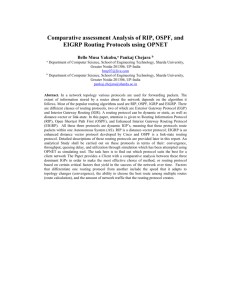

![Internetwork & TCP/IP [Opens in New Window]](http://s3.studylib.net/store/data/008490208_1-eaf10231908f97f1b47b18fe3c507663-300x300.png)
